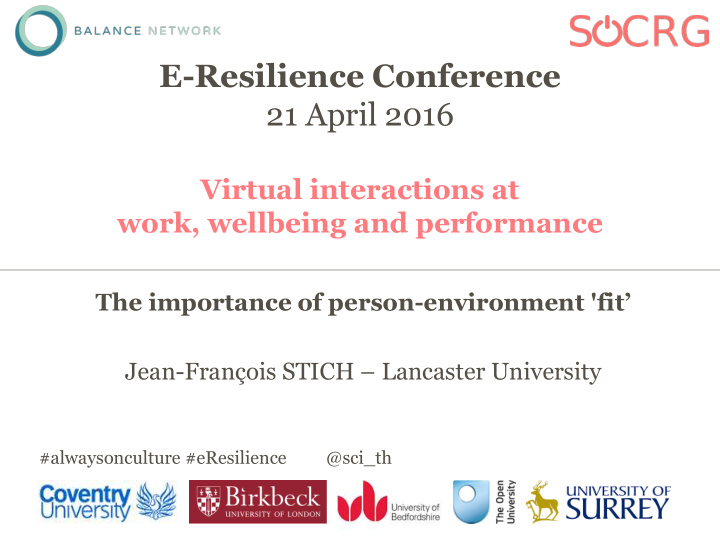



E-Resilience Conference 21 April 2016 Virtual interactions at work, wellbeing and performance The importance of person-environment 'fit’ Jean-François STICH – Lancaster University #alwaysonculture #eResilience @sci_th
Virtual interactions and wellbeing The tools of the trade #alwaysonculture #eResilience @sci_th 2 21 April 2016
Personal preferences regarding virtual interactions The case of email load #alwaysonculture #eResilience 3 21 April 2016
Virtual interactions and wellbeing Personal preferences: the case of email overload Email overload Causes : lots of emails sent/received, time spent managing emails, email interruptions… (Sumecki et al., 2011; Soucek & Moser, 2010; Barley et al., 2011) Consequences : workplace isolation, decreased job control, longer and faster paced workdays, stress, burnout, absenteeism, loss of productivity… (McMurtry, 2014; Barley et al., 2011; Barber & Santuzzi, 2015; Mano & Mesch, 2010) #alwaysonculture #eResilience @sci_th 4 21 April 2016
Virtual interactions and wellbeing Personal preferences: the case of email overload But how many emails to feel overloaded? 200, 50, 100, 10… It depends… (Karr-Wisniewski & Lu, 2010; Ingham, 2003) Because email overload is individual/subjective Users’ perceptions that their email use has got out of control (Dabbish and Kraut, 2006) Mitigated by positive attitudes (Sumecki et al., 2011) #alwaysonculture #eResilience @sci_th 5 21 April 2016
Virtual interactions and wellbeing Personal preferences: Expanding the case Strong attitudes towards Virtual / Face-to-face ICT outside working hours: Some individuals ask for this remote access , feel empowered, more satisfied, more productive, more “professional” (Diaz et al., 2012) Aware of the trade-offs (Matusik and Mickel, 2011) Less work-life conflict for individuals who have a positive view on this connectivity (Wright et al., 2014). #alwaysonculture #eResilience @sci_th 6 21 April 2016
Virtual interactions and wellbeing So what? • Personal preferences and appraisal regarding virtual interactions matter • But how do they impact wellbeing? • Moderating the use – wellbeing relationship • Guiding use • … • My hypothesis: Personal preferences have to match actual use #alwaysonculture #eResilience @sci_th 7 21 April 2016
My hypothesis Personal preferences have to match actual use A Person-Environment Fit approach to wellbeing and virtual interactions at work #alwaysonculture #eResilience 8 21 April 2016
Virtual interactions and wellbeing Person-Environment Fit Actual use Desired use Fit Actual extent of Desired extent of communication communication Misfit (e.g., using email) (e.g., using email) “Satisfactory use” (fit) -> more wellbeing “Unsatisfactory use” (misfit) -> less wellbeing #alwaysonculture #eResilience @sci_th 9 21 April 2016
My studies Pilot study Main study Cross-sectional survey (N=118) Cross-sectional survey (N=504) Interviews (N=23) #alwaysonculture #eResilience 10 21 April 2016
Virtual interactions and wellbeing Quantitative study: method Sample : 118 U.S. workers from a Qualtrics panel Questions : Actual and desired use of virtual interactions Wellbeing (ASSET by Robertston Cooper Ltd) #alwaysonculture #eResilience @sci_th 11 21 April 2016
Virtual interactions and wellbeing Quantitative study: results Impact of the amount of emails alone on relationship stress None! #alwaysonculture #eResilience @sci_th 12 21 April 2016
Virtual interactions and wellbeing Quantitative study: results Relationship Actual AND stress desired amounts 48 43 38 Stress when both too many and too few 33 emails 28 23 Less stress when High 18 interacting the way 13 Medium Desired we want 8 volume of High emails Medium Low Actual volume of emails Low #alwaysonculture #eResilience @sci_th 13 21 April 2016
Virtual interactions and wellbeing Quantitative study: other results Same fit relationships for: Email load & Work relationships stressor Email load & Job conditions stressor Email load & Job control stressor No fit relationships for the other media Only actual volume impacted wellbeing #alwaysonculture #eResilience @sci_th 14 21 April 2016
Virtual interactions and wellbeing Qualitative study: methods Sample : 23 employees from a French IT company Questions : Use of virtual interactions Perceptions of virtual interactions Perceived impact of virtual interactions on wellbeing #alwaysonculture #eResilience @sci_th 15 21 April 2016
Virtual interactions and wellbeing Qualitative study: results Other types of ‘fit’ Desired and actual volume ‘I am not an e - mail person very much, so I don’t even like when there are few of them [laughs].’ Desired and imposed virtual interactions ‘After two hours, I log into the instant messaging system and I send a message ‘so have you seen my e- mail?’ I think it puts a bit of pressure [laughs]’. Desired and available media “It is good here that people are using instant messaging and face -to-face interactions. This is quite efficient to avoid having a substantial volume of e-mail .” One’s desired virtual interactions and those of others “I limit my phone calls a lot. I never call. I don’t like “ I am more of a phone person . [ … ] I send an the phone , I don’t know why [laughs]. I don’t like instant message with ‘hey, do you have a minute?” it, and I don’t like it either when I am called. ” and if they say yes, I call them straight away. ” #alwaysonculture #eResilience @sci_th 16 21 April 2016
Virtual interactions and wellbeing Implications 1. Identify fit or misfit 2. Tackle misfit Actual use Preferences • Adjust volume • Adjust preferences • Policies • Empathy coaching • Training… • No email week • Adjust available media • Share preferences • Adjust teams #alwaysonculture #eResilience @sci_th 17 21 April 2016
Thank you www.jfstich.com #alwaysonculture #eResilience 18 21 April 2016
Recommend
More recommend